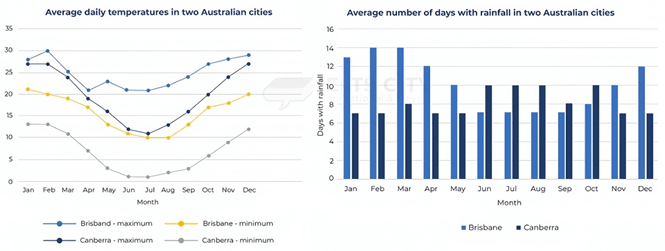5+ The graph and chart below give information on the average daily maximum and minimum temperature
The graph and chart below give information on the average daily maximum and minimum temperature in degrees Celsius and the average number of days with rainfall each month for two Australian cities. Summarise the information by selecting and reporting the main features, and make comparisons where relevant. Write at least 150 words hay nhất giúp bạn có thêm tài liệu tham khảo để viết bài luận bằng Tiếng Anh hay hơn.
- The graph and chart below give information on the average daily maximum and minimum temperature (mẫu 1)
- The graph and chart below give information on the average daily maximum and minimum temperature (mẫu 2)
- The graph and chart below give information on the average daily maximum and minimum temperature (mẫu 3)
- The graph and chart below give information on the average daily maximum and minimum temperature (mẫu 4)
- The graph and chart below give information on the average daily maximum and minimum temperature (mẫu 5)
- The graph and chart below give information on the average daily maximum and minimum temperature (mẫu 6)
- The graph and chart below give information on the average daily maximum and minimum temperature (mẫu 7)
- The graph and chart below give information on the average daily maximum and minimum temperature (mẫu 8)
5+ The graph and chart below give information on the average daily maximum and minimum temperature
Đề bài: The graph and chart below give information on the average daily maximum and minimum temperature in degrees Celsius and the average number of days with rainfall each month for two Australian cities. Summarise the information by selecting and reporting the main features, and make comparisons where relevant. Write at least 150 words
The graph and chart below give information on the average daily maximum and minimum temperature - mẫu 1
The graphs show the average daily temperatures in two Australian cities and the average number of days per month with rainfall.
Overall, the minimum and maximum temperatures in Brisbane were higher than those in Canberra in general. Additionally, while the average daily temperature trends were similar between the two cities, with cooler weather occurring from April to September, the rainfall trends were opposite.
In Brisbane, the hottest average daily maximum temperature occurs in February, reaching around 30℃. Canberra’s hottest average maximum daily temperatures occur from December to February and reach approximately 27℃. The lowest average daily minimum temperature in both cities occurs in July, dropping to around 10℃ in Brisbane and 1℃ in Canberra.
Meanwhile, the highest average number of days with rainfall in Brisbane are in December to April, with the highest figures occurring in February and March at 14 days with rainfall per month. Canberra, on the other hand, experiences its rainiest months from June to August, at an average of 10 days with rainfall per month.
The graph and chart below give information on the average daily maximum and minimum temperature - mẫu 2
The charts compare the lows and highs in average daily temperatures (°C) as well as the average number of rainy days during a year between two Australian cities, Brisbane and Canberra.
The statistics reflect that Brisbane is much warmer than Canberra. However, they both have in common that their temperatures tend to be higher in the first and last quarters of the year. As for rainfall, Brisbane generally experiences more rainy days than Canberra, except between June and October.
Maximum temperatures in Brisbane peak in February (30°C) and December (28°C), lowering towards June and July (21°C). Canberra’s warmest months also coincide with Brisbane’s, although the temperature is not as high (27°C). Nevertheless, in June and July, Canberra’s maximums (11–12°C) almost equal Brisbane’s minimums (10–11°C), while its minimums even get close to freezing point (1–2°C).
At its summit, Brisbane records up to 13–14 days of rainfall in the first quarter, while Canberra shows only half of that figure. In April, May, November, and December, the gap lessens, yet Brisbane’s figures (10–12) are still significantly higher than Canberra’s (7). Only from June to October does the reverse happen: Canberra experiences 8–10 days of rainfall compared to 7–8 days in Brisbane.
The graph and chart below give information on the average daily maximum and minimum temperature - mẫu 3
The line graph juxtaposes the mean daily temperature in Brisbane and Canberra throughout a year, whilst the bar graph delineates the frequency of precipitation each month in these two cities.
It is readily apparent that Canberra experiences lower temperatures than Brisbane during both winter and summer. An intriguing observation is the higher incidence of rainfall in Brisbane's summer, whereas Canberra records a greater number of wet days in the winter.
Focusing on temperature, Brisbane witnesses similar patterns of daily maximum and minimum temperatures, approximately 27 and 25 degrees respectively, during the months of January and March. However, July records a notable disparity of 10 degrees. In stark contrast, Canberra maintains a steady monthly temperature variation of about 7 degrees, demonstrating a less pronounced fluctuation compared to Brisbane.
Turning to precipitation, Brisbane registers the highest frequency of rainy days in February and March with 14 days each, followed closely by January with 13 days and 12 days each in April and December. On the other hand, Canberra's weather pattern displays a distinct consistency from June to August, with each month experiencing 10 wet days. Interestingly, the rainfall days in Canberra in October align with Brisbane's November, equating to a third of the month.
The graph and chart below give information on the average daily maximum and minimum temperature - mẫu 4
The line graph provides a comparative study of the average daily temperature fluctuations in Brisbane and Canberra over the span of a year, while the bar graph elucidates the frequency of rainy days on a monthly basis in the aforementioned cities.
Upon analysis, it is indisputable that Canberra is generally cooler than Brisbane during both winter and summer. Notably, Brisbane experiences a higher incidence of precipitation in the summer, whilst Canberra sees more rainy days in the winter season.
With regards to the temperature variations, the peak and the trough temperature during January and March in Brisbane are strikingly similar, at around 27 degrees and precisely 25 degrees respectively. Contrastingly, the greatest temperature variance is observed in July with a divergence of 10 degrees. Conversely, Canberra presents a uniform temperature difference of around 7 degrees each month, underscoring its lesser temperature fluctuation as compared to Brisbane.
In terms of precipitation, Brisbane endures the most rainfall with 14 rainy days in February and March, 13 days in January and 12 days in both April and December. However, Canberra sees a steady rate of rainfall from June to August, with each month recording 10 rainy days. Intriguingly, the occurrence of rainy days in Canberra in October mirrors that in Brisbane's November, tallying to approximately a third of the month.
The graph and chart below give information on the average daily maximum and minimum temperature - mẫu 5
The graph and chart illustrate the average daily temperatures and the average number of rainy days between two cities in Australia: Brisbane and Canberra.
The data indicate that Brisbane is significantly warmer than Canberra. However, both cities share a similar temperature pattern, where the temperature tends to be higher in the first and last quarters of the year. In terms of rainfall, Brisbane generally has more rainy days than Canberra, except for the period between June and October.
Brisbane experiences its highest maximum temperatures in February (30°C) and December (28°C), which then decrease towards June and July (21°C). Similarly, Canberra's warmest months coincide with Brisbane's, although the temperature is not as high (27°C). However, in June and July, Canberra's maximum temperatures (11-12°C) almost match Brisbane's minimum temperatures (10-11°C), while its minimum temperatures can even reach a freezing point (1-2°C).
Brisbane has up to 13-14 days of rainfall in the first quarter, while Canberra only has half that figure. In April, May, November, and December, the difference between the two cities lessens, but Brisbane's figures (10-12) are still significantly higher than Canberra's (7). Only from June to October does the situation reverse, with Canberra experiencing from 8 to 10 days of rainfall compared to 7-8 days in Brisbane.
The graph and chart below give information on the average daily maximum and minimum temperature - mẫu 6
The graph and chart provide information on the average daily temperatures in degrees Celsius and the number of rainy days per month for Brisbane and Canberra in Australia.
Overall, Brisbane has a higher temperature than Canberra all year round, with the highest temperature in Brisbane recorded in February. Brisbane experiences more rainy days each month from November to May, whereas Canberra has more rainy days from June to October.
Brisbane's maximum daily temperature reaches 30°C in February before dropping to 21°C in April. After rising to 23°C, it again falls to 21°C in June and July. In comparison, Canberra's temperature drops to approximately 11°C in July, only half of Brisbane's temperature. In the last five months of the year, both cities experienced an increase in temperature, with Brisbane reaching around 29°C and Canberra around 27°C in December. Regarding the minimum daily temperature, Brisbane starts at around 21°C in January and gradually decreases to 10°C in July and August before rising to 20°C at the end of the year. Canberra's minimum daily temperature follows a similar pattern, starting at 18°C in January, dropping to 1°C in June and July, and rising to approximately 12°C in December.
In addition, Brisbane experiences an increase in rainy days from 10 in November to 14 in February and March before decreasing to 10 in May. Canberra experiences around six rainy days per month for most of the year. From June to October, Brisbane has only 7 or 8 rainy days per month, while Canberra has 8 to 10 rainy days.
The graph and chart below give information on the average daily maximum and minimum temperature - mẫu 7
The graph and charts compare the temperatures in degrees Celsius and the number of rainy days monthly in Brisbane and Canberra, Australia.
Despite similar periodic fluctuations, Brisbane’s maximum and minimum temperatures are consistently higher than Canberra’s. Moreover, the largest numbers of days with rainfall in Brisbane fall in the first half of the year, but an opposite pattern is recorded in Canberra.
Brisbane’s maximum and minimum temperatures start at 28 and 27 degrees, the gap of which widens from April to July and ultimately makes a striking difference of 10 degrees. The temperatures soar in the remaining months and similarly end at under 30 degrees. Meanwhile, Canberra’s statistics maintain a gap of 8-10 degrees throughout the period. Standing at 22 and 13 degrees in January, this city’s maximum and minimum temperatures experience a significant drop, reaching troughs of 10 degrees and 1 degree in July, before starting to rise again later in the year. Regarding the number of days with rainfall, Brisbane experiences 10-14 rainy days in the first five months, with the peaks recorded in February and March. After a plateau of 10 days between June and August, this figure reduces by three days in December. Meanwhile, Canberra experiences seven rainy days from January to September, with eight days in March being the exception. In the last quarter of the year, this figure sees a 50% surge to end at 12 days.
The graph and chart below give information on the average daily maximum and minimum temperature - mẫu 8
The provided graph displays the average daily maximum and minimum temperatures in degrees Celsius (°C) for Brisbane and Canberra, while the accompanying chart illustrates the average number of days with rainfall in each city per month.
Overall, both cities experienced a decline in average daily temperatures from February to July. Brisbane consistently recorded higher temperatures than Canberra. Furthermore, Brisbane generally experienced a greater number of rainy days than Canberra, although Canberra showed a higher number of rainy days between June and October.
In January, both cities had similar average daily maximum temperatures, around 27°C. Brisbane reached its peak average daily maximum temperature of 30°C in February, while Canberra's remained relatively constant. From February to July, both cities experienced a decline in maximum temperatures; Brisbane's dropped to 21°C and Canberra's to 11°C. Subsequently, temperatures in both cities gradually rose, reaching 29°C in Brisbane and 27°C in Canberra by December.
Concerning rainfall, Brisbane saw a relatively constant number of rainy days, fluctuating between 12 and 14 days from December to March. This contrasted with a lower average of 7 days from June to September. Canberra, conversely, exhibited more stable rainfall patterns, with 7 or 8 rainy days from November to May, increasing to 10 days from June to August.
Xem thêm các bài luận Tiếng Anh hay khác:
Đã có app VietJack trên điện thoại, giải bài tập SGK, SBT Soạn văn, Văn mẫu, Thi online, Bài giảng....miễn phí. Tải ngay ứng dụng trên Android và iOS.
Theo dõi chúng tôi miễn phí trên mạng xã hội facebook và youtube:Nếu thấy hay, hãy động viên và chia sẻ nhé! Các bình luận không phù hợp với nội quy bình luận trang web sẽ bị cấm bình luận vĩnh viễn.
- Đề thi lớp 1 (các môn học)
- Đề thi lớp 2 (các môn học)
- Đề thi lớp 3 (các môn học)
- Đề thi lớp 4 (các môn học)
- Đề thi lớp 5 (các môn học)
- Đề thi lớp 6 (các môn học)
- Đề thi lớp 7 (các môn học)
- Đề thi lớp 8 (các môn học)
- Đề thi lớp 9 (các môn học)
- Đề thi lớp 10 (các môn học)
- Đề thi lớp 11 (các môn học)
- Đề thi lớp 12 (các môn học)
- Giáo án lớp 1 (các môn học)
- Giáo án lớp 2 (các môn học)
- Giáo án lớp 3 (các môn học)
- Giáo án lớp 4 (các môn học)
- Giáo án lớp 5 (các môn học)
- Giáo án lớp 6 (các môn học)
- Giáo án lớp 7 (các môn học)
- Giáo án lớp 8 (các môn học)
- Giáo án lớp 9 (các môn học)
- Giáo án lớp 10 (các môn học)
- Giáo án lớp 11 (các môn học)
- Giáo án lớp 12 (các môn học)






 Giải bài tập SGK & SBT
Giải bài tập SGK & SBT
 Tài liệu giáo viên
Tài liệu giáo viên
 Sách
Sách
 Khóa học
Khóa học
 Thi online
Thi online
 Hỏi đáp
Hỏi đáp

